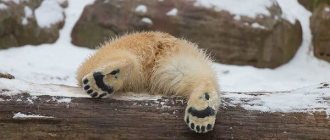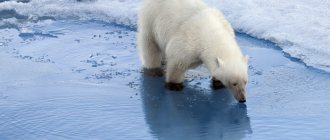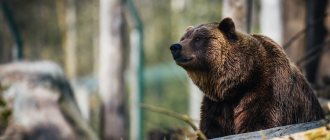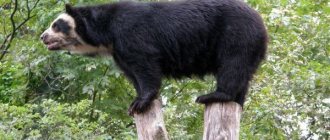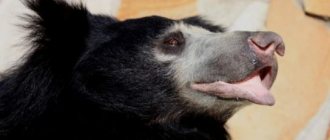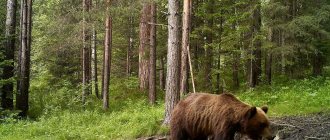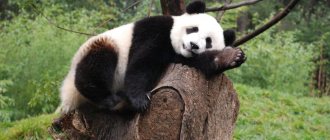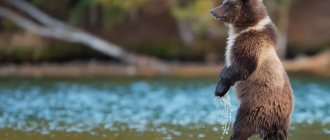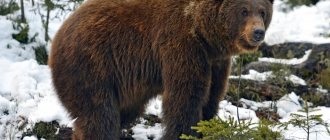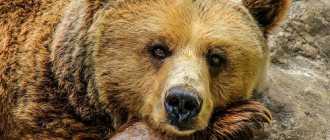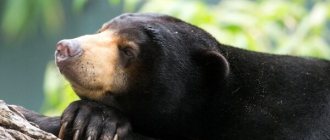09 July32128bear familypredator dart frog
The Himalayan bear (other names: white-breasted bear, black Himalayan bear, black Ussuri bear) is a predatory species of mammals from the Bear family. The Himalayan bear is often called the "moon bear" because of its white patch on its chest, which is shaped like a crescent moon. In this article you will find a description of the Himalayan bear and photos, you will learn a lot of interesting and new things about this unique animal.
Origin of the species and description
The origins of the white-breasted population are traced back to ancient bear individuals, from which all modern bears originated. White-breasted bears are much smaller in size than brown varieties of bears, but differ from them in having the most fit physique.
The lifespan of bears is no more than 27 years. The maximum lifespan of a moon bear in captivity is 30 years.
Grizzly
The largest representative of the Bear family, living in Canada and Alaska.
This giant bear weighs up to 450 kilograms, and its body length reaches 280 centimeters. It has a gray-brown color, with a gray tint, which is why its coat looks lighter compared to the brown subspecies. The fur is shaggy, thick with long pile. The skull is shorter compared to European species, the forehead is flat, widened, with convex nasal bones.
In behavior and lifestyle, the grizzly bear resembles its closest relative, the brown bear. Despite many legends describing this bear as a terrible, ferocious predator that kills a person with one blow of its paw, the grizzly bear rarely attacks first. The diet of the species depends on the region of residence. Among individuals inhabiting the coasts, this is mainly salmon or other fish. Bears that settle in forests have berries, fruits, nuts or roots. Or small animals.
Interesting fact: a grizzly bear attacks a person in exceptional cases. But, due to poor eyesight, during a hunt it reacts to any moving object, so you should not approach it under any circumstances. Especially if it is a bear with babies.
Appearance and features
The head of an adult is relatively small, with a long narrow muzzle and large, wide-standing, funnel-shaped ears. The animal has long, thick fur and a white patch in the shape of the letter “V” on its chest. The wide croup of the animal is much larger than the withers.
The large claws of adults are strong, strongly curled and pointed. The legs, especially the front ones, are very powerful, strong and longer than the hind ones. Bears have a total of 42 teeth.
The individuality of this type is not sufficiently expressed. The fur is shiny, black, and there is a snow-white or yellow V-shaped spot on the chest, which is why the animal is called white-breasted. The body length of an adult male is 150-160 cm, sometimes reaching 200 cm. Females are smaller, up to 130-140 cm long.
Winter dream
Traces of a male Himalayan bear leaving its den after winter sleep. Ice covered with snow on the river. Bykova (March 2005)
Winter sleep usually lasts from October to April. As a rule, in the fall, adult males are the last to lie down in dens. They are active until the end of November, but occasionally wander until the beginning of winter. Thus, on December 5, 1995, fresh traces of an adult male bear were discovered in the right-bank valley of the Zolotoy stream. In spring, adult males are also the first to leave dens. For example, traces of a large bear (the width of the print of the palmar callus - the large pad of the front paw - 12 cm) approximately one day old were found on March 31, 2005 in the valley of the river. Bykova. On a two-kilometer route along the bear's trail (in the direction opposite to the direction of the animal's movement), a ground spring nest of the bear was found, where it waited out the snowfall, and three anthills dug by it.
Where does the white-breasted bear live?
The geographic habitat of moon bears is associated with the presence of wild tropical and subtropical deciduous forests. Animals live in virgin cedar and deciduous Manchurian forests, oak groves and cedar forests, in groves with Manchurian nuts or Mongolian oaks.
These thickets are distinguished by a variety of nuts, various berries and other fruits - the main diet of the moon bear. Animals live in the highlands during the hot summer season, and by winter they move lower into warmer lowland thickets.
A significant part of the white-breasted bear's territory extends to East Asia. Animals are found in other warm countries: China, Afghanistan, the Himalayas, Indochina, Korea, Japan. In the Russian Federation, Himalayan individuals live only in the Ussuri region and the Amur region. The animal can be found high in the mountains, at an altitude of more than 3000 km.
The habitat area of the white chestnut in the Russian Federation entirely coincides with the area of broad-leaved, oak and cedar forests.
Baribal
This huge bear with beautiful, shiny, jet-black fur lives in North America, inhabiting vast regions from Alaska to Mexico.
The color of the muzzle is lighter. The height at the withers is about a meter. The length of an adult male is from 140 to 200 cm, weight – up to 360 kg. Females are smaller. The color of the baribal acquires a rich dark color in the second year of life. Juveniles of the species are light gray.
The habitat of this species is mountain and lowland forests. It comes out into open spaces in search of food, which is why it often dies in a collision with a person. In winter he sleeps in a den. The baribal's diet consists of plants, berries, and insects. Sometimes he eats fish. Will not refuse meat and even carrion.
It is not aggressive, does not attack people, but can climb into outbuildings to profit from something “tasty.” Unfortunately, the species' numbers are gradually declining due to road accidents and shooting by hunters.
What does the white-breasted bear eat?
Lenten food dominates the menu of Himalayan bears:
- ordinary nuts, hazel;
- oak acorn and pine nut;
- various sweet berry fruits;
- herbal plants, buds or leaves of trees.
Bears love bird cherry and raspberry berries. When there is an abundant harvest, animals concentrate in the floodplains of rivers and springs and enjoy the sweet berries with pleasure. Bears often devastate apiaries; in some cases, the bear drags the stolen hive into the water to neutralize the bees.
Bears often eat animal food - small insects, worms, larvae. Even in a hungry spring, after awakening from hibernation, white-breasted fish do not prey, do not fish, but do not neglect carrion. Sometimes bears may attempt to attack wild horses or livestock. Bears can also be dangerous for humans.
Habitats
The Himalayan bear is distributed throughout the reserve. Its main habitats are broad-leaved forests of the foothills and plains and coniferous-deciduous forests of the middle mountains. In summer, it is often found in secondary deciduous forests, even near populated areas. Although the Himalayan bear leads a solitary lifestyle, during the ripening of Mongolian oak acorns and Korean cedar nuts - the main food that allows them to quickly accumulate a sufficient amount of fat before winter sleep - they form temporary clusters. Mountain fir-spruce forests at an altitude of 600–900 m above sea level. m. are unattractive to him. Rarely visits the sparsely forested plains of the Kiya-Chirki interfluve located to the south of the reserve.
It is extremely rare to see a Himalayan bear in the open during the day. I had the opportunity to observe this only once, on July 29, 2008. A bear in the middle of the day crossed the very shallow lake Peshkov Bay at the mouth of the river. Teal. He headed from the river on the left bank to the forests of Greater Khekhtsir, the distance to which was approximately 1 km. The bear either ran or walked quickly. It was very hot (31–33°C), so when he entered the shallow channels, he lay down in the water to cool off, but each time he rested for no more than a minute.
A bear crosses the heavily shallowed lake Peshkov Bay at the mouth of the river. Teal. On right
- rises from the water after a short rest (July 2008)
Features of character and lifestyle
The Himalayan bear is an excellent tree climber and has a semi-arboreal lifestyle. The lunar beast spends more than 50% of its life on the tops of trees. There he makes a living, obtaining his own food, and escapes from opponents and annoying midges.
It costs nothing for a bear to climb to the top of a large tree, up to 30 m high, in 3-4 seconds. From a height of 6-7 meters the animal jumps easily, without hesitation. Climbing onto the crowns of large cedars, the animal sits on thick branches. By breaking off the branches around itself and eating tasty fruits from them, the animal obtains its food. The intelligent animal does not throw away the gnawed branches, but places them under itself as bedding. The result is a cozy nest that can be used for an afternoon nap in a safe place.
When meeting a person, the animal slowly moves away, episodes of hostile behavior are rare. Bears never accidentally attack people. After shots and wounds, he often runs away, but can decisively rush at his offender. Mother bears protecting cubs aggressively make threatening attacks towards a person, but only complete the attack if the person escapes. This type has considerable physical strength and good mobility.
White-breasted bears behave like ordinary bears in hibernation:
- they do not excrete urine or feces;
- during hibernation, heart rate decreases from 40-70 to 8-12 beats per minute;
- metabolic processes are reduced by 50%;
- Body temperature drops by 3-7 degrees Celsius, so the bear can easily wake up.
At the end of the winter period, males lose up to 15-30% of their weight, and females lose up to 40%. Bears leave the den around mid-April 2.
The white-breasted bear has a wonderful memory; he remembers good and bad well. And the spectrum of mood is very wide - from peaceful, quiet to extremely agitated and angry.
Relationship with a person
The bear has long evoked different feelings in people: from fear to fascination. From childhood, young children were introduced to fairy tales, where the characters were mysterious and kind bears, heroes of numerous tales and legends.
The image of a Himalayan bear is located on the coat of arms of the city of Khabarovsk and the regions of the Khabarovsk Territory of Russia. However, people have long hunted clubfoot. They have always been attracted to the meat, skin, bile and fat of animals, which were actively used in traditional medicine.
The Himalayan toptygin is not as dangerous to humans as the brown bear. Usually a black bear, sensing the scent of a person, tries to quickly run away from this place. But if he is wounded, he can attack his offenders.
The she-bear also protects babies from humans; she rushes at people. She also tries to lead the cubs away from danger, drives them into a tall tree, and then climbs there herself.
Social structure and reproduction
White-breasted bears communicate with each other using a loud voice. If cubs are isolated from their mothers, they emit a calling cry. Low guttural sounds can be a sign of toptygin's dissatisfaction, and at the same time with the clicking of teeth - his hostility.
The Himalayan animal often spends its entire winter hibernation in the hollows of large trees. Large hollows in large trunks of poplars or lindens are more convenient for wintering. Access to such a lair is no lower than 5 m from the soil. According to the weight of an adult bear, suitable trees must be at least 90 cm in diameter.
Less often, when there are no large trees or they have been cut down, the bear can spend the winter in other suitable hidden places:
- in holes under tree roots;
- in built large nests under the trunks of fallen trees;
- in rock caves, crevices or grottoes.
The Ussuri bear is characterized by seasonal movements of its wintering grounds to deciduous forests and back, with transitions taking place along the same routes. Wintering areas are concentrated in areas separated by large watersheds. Most often, the winter den is located within a personal area, and near the den the white-breasted bear tries to confuse the tracks so as not to give away its location.
Apart from the mating season, moon bears lead a solitary existence, from time to time accumulating several individuals in areas with abundant food. Among the white-breasted fish, some social hierarchy can be traced, associated with different ages and weights of males. This is especially true during the mating season. Those young males whose weight is less than 80 kilograms have almost no chance of copulating with females.
Bears often establish optical contact with each other when, through their postures and movements, they show their dominant or subordinate status. To determine subservient status, the bear retreats, sits down, or lies down. To prove its own dominant position, the bear walks forward or runs towards its opponent.
To communicate with other white-breasted bears, the animals use their own acute sense of smell. Animals make their marks: they urinate on tree trunks or itch and rub against tree trunks. Animals do this in order to retain their own scent on them. The opponent will immediately smell the owner of the territory and go home. Private areas can be 5-20 and even 35 square meters. km. This depends on the availability of food on the site. The more and more varied the forage, the smaller the territory.
The white-breasted bear is a polygamous creature. Females enter mating periods at random intervals. Therefore, copulation can occur with different males within 10-30 days. Pairs occur for a short period of time.
The breeding season lasts from mid-June to mid-August. The young generation of animals reaches sexual adulthood at the 3rd year of life, but numerous females are often left without offspring. Pregnancy lasts 7-8 months. The female usually gives birth to up to 2 cubs at the end of December or mid-January. Cubs weighing 250-350 grams appear, they take a long time to form and even at the age of 2 months are absolutely defenseless. Babies stop drinking milk at 3.5 months.
Tree feeding
A nest-like structure made on a bird cherry tree by a Himalayan bear.
Right bank valley of the river Ussuri in the vicinity of the Chirki cordon (August 2002) Usually, in order to get to the fruits, Himalayan bears climb trees (Maak and common bird cherry, Mongolian oak, etc.), where they feed, making creases similar to nests. But in some cases, they drop branches with a diameter of 6–8 cm from a tree, for example, from a Mongolian oak or Korean cedar: first they gnaw them and then break them off. They are extremely careful and at the slightest danger they get down to the ground and run away. Far from roads and populated areas they can feed at different times of the day, but near them - mainly at night.
However, there are exceptions. For example, on July 29, 2004 at two o'clock in the afternoon on the right bank of the river. In Ussuri I met a Himalayan bear feeding in the crown of a bird cherry tree. I managed to get within 10 meters of him. He went about his business absolutely calmly, although on the river Chinese fishermen were fishing in junks: the hum of the engines was clearly audible, and people were clearly visible from the shore. Noticing me, the bear hastily climbed down from the tree and disappeared into the forest.
Natural enemies of the white-breasted bear
The enemies of white chests are large wolves, tigers, and brown bears. The most dangerous is the tiger, from whose claws it is difficult to escape alive. But the destruction of Himalayan bears by predators is very rare, since bears are very strong animals and are able to give a worthy rebuff to any predator. The decline in the number of Himalayan bears is considered only the result of human activity.
Daily activity
The daily activity of the Himalayan bear was determined from encounters with animals and data from camera traps (82 registrations in total). These predators are mostly passive at night (from 00:00 to 4:00). During daylight hours (from 8:00 to 16:00) they are most active. After 22:00 there is a period of relative peace.
We managed to see resting Himalayan bears four times (once with the help of a camera trap). Twice the resting places were located on almost horizontally growing tree branches four to five meters from the ground (in the vicinity of the Tsypinsky settlement), once in a grotto in a rocky outcrop, and once again on the ridge of the same outcrop (in the upper reaches of the Bykova River). Bears resting on the branches were discovered both times in the second hour of the day; the bear was scared away from the grotto at the beginning of the third hour of the day. A camera trap installed on the ridge of a rocky outcrop recorded how a Himalayan bear settled there for the night on July 15, 2014 at five o’clock in the morning and slept for an hour and a half. Thanks to camera traps, it turned out that Himalayan bears often climb this outcrop.
Bears periodically climb onto the rocky outcrop in the upper reaches of the river. Bykova (July 2014)
Population and species status
With the relatively low rate of reproduction of white-breasted bears, there is a constant decline in the population size. Females give birth to their first offspring only after 3-4 years of existence. No more than 35% of females take part in breeding each year. Each increase in fishing pressure leads to a rapid decline in the population. Also, fires, numerous logging and poaching lead to a decrease in the population.
The white-breasted bear is a valuable object for illegal hunting by poachers. It is often shot to obtain expensive bile and tasty bear meat. White-breasted bears are often hunted for their beautiful skins and valuable fur.
Big panda
The calling card of the species is its cute “plush” appearance and bright contrasting color with black spots around the eyes, black paws and ears. Habitat: mountainous regions of China.
The main part of the diet is bamboo. For this reason, it is often called the bamboo bear, and also the “cat bear” or “spotted bear.” Sometimes the panda “dilutes” its “herbivorous diet” with protein foods, consuming insects, small birds or their eggs. The panda grows in length up to 120-180 cm and weighs up to 160 kg. The body of the animal is massive, stocky. Females are slightly larger in size than males.
The front paws of a giant panda have an unusual structure: in addition to five fingers, they have an additional process in the form of a “thumb,” which is one of the modified bones of the wrist joint. With its help, the animal can easily cope with bamboo shoots of any thickness.
The bamboo bear is active throughout the year and does not hibernate. He can climb trees, but does it rarely. Spends most of his time eating bamboo. Not aggressive, but there are known cases of panda attacks on humans.
Thanks to the active participation of environmental organizations and the Chinese government in protecting the species, the number of giant pandas was partially restored. Today, it has moved from endangered to vulnerable.
Lifestyle
Most bears live in forests.
All types of bears lead a sedentary lifestyle. The exception is the white one, which can periodically migrate and occupy new territories. Mother bears live with their cubs while they become accustomed to the world around them. Adult males stay solitary and occupy a specific location. If several individuals live in one forest, then each one respects the established boundaries, hunting only on their own lands.
Interesting fact : bears mark their territory by leaving marks on trees using their claws. The animal also marks its boundaries with the help of smell.
Throughout the day, the bear walks around its territory and looks for food. Having eaten enough, the predator returns to the den - a large hole dug in the ground. There he sleeps and rests. Closer to winter, the animal begins to eat food in large quantities in order to gain weight. With the onset of cold weather, it goes into hibernation, and its body functions at the expense of fat, the mass of which can reach up to 200 kg. This turns out to be enough to remain in a state of suspended animation for several months without harm to health.
Kodiak
This animal is a real giant, and the largest bear of the brown bear species. One of the largest land predators on our planet. It grows up to 280 cm with a body weight of up to 780 kg (according to Wikipedia).
The habitat is an island near Alaska with the same name, Kodiak. The bear settles on their coast, where it hunts fish or small mammals living near the water. Also eats plants, berries, herbs, and nuts.
The body of the animal is muscular, powerful, with elongated legs and a large head. The color of the coat varies from light brown to dark in individuals living in the southern regions. They are convinced loners, living separately from other relatives, uniting with females only during mating.
By the 40s of the 20th century, the number of individuals of this species began to rapidly decline due to active hunting. Therefore, the shooting of animals is regulated by the state. According to US law, it is allowed to shoot no more than 160 Kodiaks per year.
How long do bears live - in the wild and in zoos?
Bears are considered to be the longest-lived animals.
Bears grow and develop for quite a long time by animal standards. They reach sexual maturity only at 4-6 years, and their body finally finishes forming only at 10-11. During this period they gain weight and grow.
In their natural habitat, many species live an average of 27-30 years. During this time, the bear may encounter various factors and unfavorable conditions that can significantly reduce this period.
In artificial conditions, with proper care, the animal lives much longer: up to 45 years. Being in a zoo or reserve where it is cared for, the bear does not need to go hunting, burden the body with long journeys and perform other actions that can damage its body. Accordingly, animals have the opportunity to grow and develop calmly and not spoil their health.
Interesting: Elk

